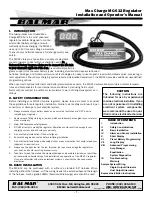
The cables should be bent or twisted as little as possible.
5
Position the radome on the mounting surface with the
triangular mark on the case aligned to the front of the vessel.
6
Apply the included anti-seize compound to the threads of the
four M8 x 1.25 x 60 threaded rods.
7
Insert the four threaded rods into the mounting holes on the
bottom of the radome.
Up to 50 mm (2 in.) of the threaded rods may extend below
the radome.
8
Apply a bead of marine sealant on the mounting surface
around each mounting hole.
9
Fasten the radome
Ä
to the mounting surface
Å
using the
threaded rods
Æ
, flat washers
Ç
, spring washers
È
, and hex
nuts
É
.
10
Using a torque wrench, tighten the nuts from 13.7 to 18.6 N-
m (10 to 14 lbf-in.) of force.
Connecting the Power Cable
WARNING
When connecting the power cable, do not remove the in-line
fuse holder. To prevent the possibility of injury or product
damage caused by fire or overheating, the appropriate fuse
must be in place as indicated in the product specifications. In
addition, connecting the power cable without the appropriate
fuse in place voids the product warranty.
1
Route the power cable from the device to the power source.
2
Connect the red wire to the positive (+) battery terminal, and
connect the black wire to the negative (-) battery terminal.
3
If you have not already done so, connect the power cable to
the device by turning the locking ring clockwise.
Power Cable Extensions
Connecting the power cable directly to the battery is
recommended. If it is necessary to extend the cable, the
appropriate gauge of wire must be used for the length of the
extension.
Distance
Wire Gauge
2 m (6.5 ft.)
16 AWG (1.31 mm²)
4 m (13 ft.)
14 AWG (2.08 mm²)
6 m (19 ft.)
12 AWG (3.31 mm²)
Connecting to a Device or to the Marine
Network
You can connect the radar either directly to a radar-compatible
Garmin device or to a Garmin Marine Network to share radar
information with all connected devices.
NOTE:
Not all Garmin devices are compatible with the Garmin
Marine Network. See the installation instructions or owner's
manual provided with your device for more information.
1
Route the network cable to your compatible Garmin device.
2
If you have not already done so, install the locking rings and
o-rings on the end of the network cable.
3
Select an option:
• If the Garmin device is not compatible with the Garmin
Marine Network, connect the network cable to the port
labeled RADAR.
• If the device is compatible with the Garmin Marine
Network, connect the network cable to the port labeled
NETWORK.
Radar Operation
All functions of this radar are controlled with your Garmin
chartplotter. See the Radar section of your chartplotter's manual
for operating instructions. To download the latest manual, go to
Measuring the Potential Front-of-Boat Offset
The front-of-boat offset compensates for the physical location of
the radar scanner on a boat, if the radar scanner does not align
with the bow-stern axis.
1
Using a magnetic compass, take an optical bearing of a
stationary target located within viewable range.
2
Measure the target bearing on the radar.
3
If the bearing deviation is more than +/- 1°, set the front-of-
boat offset.
Setting the Front-of-Boat Offset
Before you can set the front-of-boat offset, you must measure
the potential front-of-boat offset.
The front-of-boat offset setting configured for use in one radar
mode is applied to every other radar mode and to the Radar
overlay.
1
From a Radar screen or the Radar overlay, select
Menu
>
Radar Setup
>
Installation
>
Front of Boat
.
2
Select
Up
or
Down
to adjust the offset.
Specifications
Specification
Measurement
Minimum safe operating distance*
GMR 18 HD+ and 18 xHD
• 100 W/m² = 91 cm (36 in.)
• 10 W/m² = 289 cm (114 in.)
GMR 24 xHD
• 100 W/m² = 108 cm (43 in.)
• 10 W/m² = 343 cm (135 in.)
Compass-safe distance
1 m (3.28 ft.)
GMR 18 HD+ and 18 xHD weight
7.7 kg (16.95 lb.)
GMR 24 xHD weight
9.5 kg (20.9 lb.)
Temperature range
From -15 to 70°C (from 5 to
158°F)
Case material
Thermoplastic resin
Maximum antenna rotation speed
GMR 18/24 xHD
48 RPM
Maximum antenna rotation speed
GMR 18 HD+
24 RPM
Power input source
From 11 to 35 Vdc, 3.5 A
GMR 18 HD+ and 18/24 xHD Installation Instructions
3






















